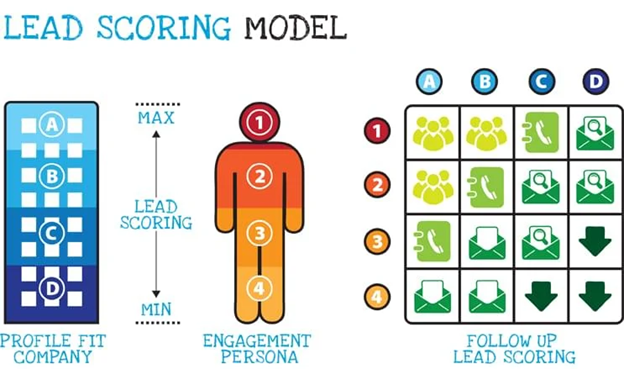
Lead scoring is a vital process for any business as it helps to prioritize and focus sales and marketing efforts on the most qualified leads.
When done correctly, lead scoring can be an extremely valuable tool for any business. By taking the time to understand your target market and identify the key factors that influence purchase decisions, you can skyrocket your sales and revenue.
However, that’s only possible if your lead scoring system works like clockwork. How do you improve its accuracy? This is what this article is all about.
Read on to learn about five effective ways to improve your lead scoring process and get the most out of your marketing efforts.

Lead scoring is a system that ranks potential leads according to their likelihood of converting into customers.
The higher the rank, the more likely it is that the lead will convert. There are many factors that go into lead scoring, including demographic information, engagement level, and company size.
While the concept is pretty straightforward, the actual implementation process can prove to be an ordeal even for large organizations with extensive resources.
According to Marketing Sherpa, lead scoring boosts the ROI of lead generation campaigns by 77%, so it’s worth taking the time to make it work.
If you have a lead scoring process in place, below, we’ll cover how to fine-tune the existing model and take your scoring system to the next level.
Read More: 7 Ways to Cleanse Your Data and Boost Lead Engagement
While lead scoring is a valuable tool, there are always ways to improve it. Here are five ways to supercharge your lead scoring system:
Companies that have aligned sales and marketing teams are typically 67% more efficient at winning paying customers. The same applies to lead scoring.
Sales and marketing teams are often the best sources of information when it comes to improving lead scoring.
They know which leads are most likely to convert, and they can provide invaluable tidbits of information needed to adjust the existing lead scoring system. You can’t get that data from third-party sources because nobody knows your customers better than your sales and marketing.
By talking to your sales and marketing teams and incorporating their feedback into your lead scoring system, you can improve its accuracy and effectiveness.
In order to improve lead scoring, it is important to adopt negative scoring attributes. This will allow you to differentiate between good and bad leads and focus your time and energy on the ones that are most likely to convert.
Some things you may want to consider including in your negative scoring attributes may include: lack of engagement, low budget, entry-level job title, and more.
By identifying and targeting these leads, you can free up the time and resources to pursue high-quality leads, drastically elevating the ROI across the board.

Lead scoring is a purely data-driven process, and no company in the world - well, except for Google and Amazon; they can do whatever they want - has enough first-party data to develop a truly powerful lead scoring system.
One of the best ways to improve your lead scoring process is to partner with a reputable B2B intent data provider.
From lead enrichment to data validation, you can significantly improve the accuracy of your model if you integrate it with third-party sources that provide insights into how your visitors actually interact with your brand online.
Choosing the right intent data provider is a mission-critical task in today’s data-driven economy, so do your research and pick wisely.
Make sure to ask the provider about their data sources and how often they update their information.
You'll also want to find out how the data is formatted and delivered, so you can make sure it will be compatible with your existing system.
Read More: 10 Proven Ways to Build a Successful B2B Sales Strategy
Predictive lead scoring is a process that uses statistical models, machine learning, and AI to predict the probability of a lead converting into a customer. It is a key component of modern demand generation and helps companies prioritize their sales and marketing efforts.
Predictive lead scoring models are typically based on historical data and take into account a variety of factors, including firmographics, demographic data, behavior data, and interactions with the company.
The goal is to build a model that can accurately predict which leads are most likely to convert so that you can focus your resources on them.
There are many different ways to approach predictive lead scoring, but one common method is using machine learning algorithms.
These algorithms analyze your historical data and look for patterns that indicate a lead is more likely to convert. Once the algorithm has been trained, you can then score new leads and prioritize them accordingly.
When it comes to improving a lead scoring system, it's important to take a systematic approach. With so many tasks to do, it’s easy to let strategic tasks slip through the cracks.
This means taking a step-by-step look at what needs to be done in order to improve the system as a whole. Here’s how:
You need to develop a lead scoring improvement plan and treat it as a standalone project.
There are several factors that need to be considered when mapping out the action plan, including.
Once these factors have been considered, it's then possible to develop a plan of action that will help to improve the lead scoring system. This plan should be tailored specifically to the needs of the business and the resources that are available.
Again, don’t treat this process as just another task. If needed, deploy a project management tool to clearly outline the work that needs to be done. Gantt charts are perfect for this task - you can use Instagantt, ClickUp, or even Google Sheets. There are a number of options to choose from.
Some of the steps that may need to be taken in order to improve a lead scoring system include:
By taking these steps, you can ensure that your lead scoring system is as effective as possible. This, in turn, can help to improve sales results and conversion rates.
Lead scoring is a vital part of any demand generation strategy. By taking the time to improve your lead scoring process, you can make sure that you're focusing your efforts on the leads that are most likely to convert.
Do you have any tips for improving lead scoring? Share them in the comments below!
He is a co-founder and digital marketing strategist at SpreadsheetDaddy, a free education resource helping users learn how to use Excel and Google Sheets more effectively.






